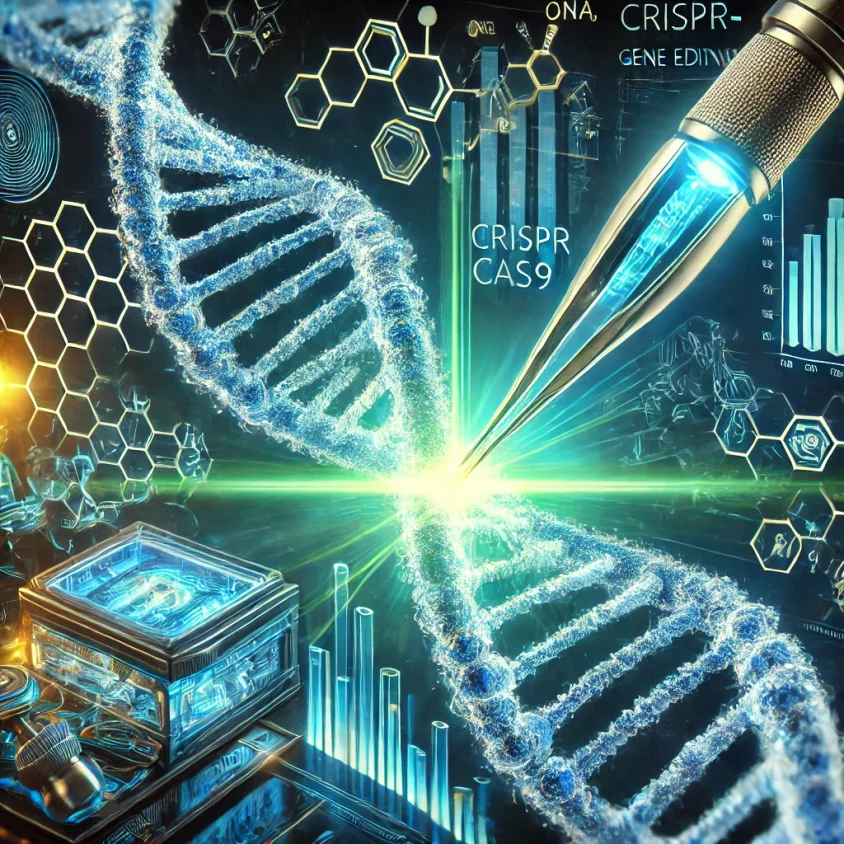CRISPR and Gene Editing: Revolutionizing Genetic Engineering

Introduction
Genetic engineering has entered a new era with CRISPR-Cas9, a revolutionary technology that enables scientists to edit DNA with unprecedented precision and efficiency. This breakthrough has far-reaching applications in medicine, agriculture, synthetic biology, and beyond.
From curing genetic diseases to creating climate-resilient crops, CRISPR is reshaping the way we manipulate genetic material. However, with great power comes great responsibility—ethical concerns, regulatory policies, and potential risks must be considered when applying this transformative technology.
This self-sufficient course will take you on a deep dive into the world of CRISPR and gene editing, equipping you with the knowledge and insights needed to understand, apply, and critically evaluate this groundbreaking field. No external guidance is required, as every concept is fully explained, ensuring an independent and complete learning experience.
📌 Course Content
1. Introduction to CRISPR and Gene Editing
1.1 What is CRISPR?
CRISPR (Clustered Regularly Interspaced Short Palindromic Repeats) is a genetic defense mechanism found in bacteria. Scientists have repurposed this system to develop a powerful tool for precisely modifying DNA sequences.
1.2 How CRISPR Works: The Mechanism Behind Gene Editing
Cas9 Enzyme: Acts as "molecular scissors" to cut DNA at a specific location.
Guide RNA (gRNA): Directs Cas9 to the target DNA sequence for modification.
DNA Repair Pathways:
Non-Homologous End Joining (NHEJ) – Creates gene knockouts.
Homology-Directed Repair (HDR) – Introduces precise genetic modifications.
1.3 History of Gene Editing Technologies
Before CRISPR, gene editing was slow, expensive, and inefficient. Early tools included:
Zinc Finger Nucleases (ZFNs)
Transcription Activator-Like Effector Nucleases (TALENs)
Meganucleases
While these techniques worked, CRISPR is cheaper, faster, and more precise than its predecessors.
2. CRISPR Applications Across Different Fields
2.1 CRISPR in Medicine: Treating Genetic Diseases
CRISPR is transforming medicine, offering potential cures for previously incurable genetic disorders:
✅ Sickle Cell Disease & β-Thalassemia – Editing hemoglobin genes to restore normal function.
✅ Cystic Fibrosis – Repairing mutations in the CFTR gene.
✅ Cancer Treatment – Engineering immune cells (CAR-T therapy) to fight cancer.
✅ Blindness & Hearing Loss – Restoring genetic mutations affecting vision and hearing.
✅ HIV & Infectious Diseases – CRISPR-based strategies to remove latent viral DNA.
2.2 CRISPR in Agriculture: Enhancing Crops and Livestock
Scientists are using CRISPR to enhance food security and sustainability:
✅ Drought-resistant crops – Engineering plants to survive in extreme climates.
✅ Disease-resistant animals – Creating livestock resistant to common infections.
✅ Nutrient-enriched foods – Improving vitamin content in crops (e.g., biofortified rice).
✅ Reducing allergens – Eliminating allergy-triggering proteins in peanuts and wheat.
2.3 CRISPR in Biotechnology & Synthetic Biology
CRISPR is revolutionizing industrial applications:
✅ Biofuel production – Engineering microbes to convert biomass into clean energy.
✅ Synthetic gene circuits – Designing organisms to perform specific biochemical functions.
✅ De-extinction projects – Reviving extinct species like the woolly mammoth.
3. CRISPR Gene Editing Process: A Step-by-Step Guide
3.1 Designing a CRISPR Experiment
1️⃣ Selecting a Target Gene – Identifying a DNA sequence to modify.
2️⃣ Designing Guide RNA (gRNA) – Choosing the correct sequence for Cas9 to cut.
3️⃣ Constructing the CRISPR-Cas9 System – Using plasmids or viral vectors.
4️⃣ Delivering CRISPR to Cells – Techniques include:
Electroporation (introducing CRISPR into cells via electrical pulses).
Microinjection (directly injecting into embryos or cells).
Viral Transduction (using modified viruses to introduce CRISPR).
5️⃣ Observing Genetic Modifications – Validating edits using PCR, sequencing, and bioinformatics tools.
3.2 Tools and Software for CRISPR Gene Editing
🔹 Benchling – CRISPR guide RNA design.
🔹 CHOPCHOP – Target selection for genome editing.
🔹 CRISPResso – Analyzing genome edits.
🔹 SnapGene – Visualizing plasmid constructs.
4. Ethical and Regulatory Considerations
4.1 Ethical Concerns in Human Gene Editing
Germline Editing vs. Somatic Editing – Should human embryos be genetically modified?
Designer Babies – Should CRISPR be used for non-medical enhancements?
CRISPR and Human Evolution – Long-term implications of genetic modifications.
4.2 Global CRISPR Regulations
FDA & NIH Guidelines – Rules for CRISPR-based clinical trials.
Global Policies – CRISPR laws in China, the EU, and other regions.
The He Jiankui Controversy – The case of the first genetically edited babies.
4.3 The Future of Ethical CRISPR Use
How do we ensure equitable access to CRISPR technology?
What safeguards should be implemented to prevent misuse?
5. The Future of CRISPR and Gene Editing
5.1 Next-Generation CRISPR Technologies
CRISPR-Cas12 & Cas13 – Expanding gene-editing capabilities.
Prime Editing – “Search-and-replace” DNA editing without cutting.
Base Editing – Directly converting one DNA letter (A, T, G, C) into another.
5.2 CRISPR Beyond Gene Editing
CRISPR Diagnostics (SHERLOCK & DETECTR) – Rapid disease detection tools.
CRISPR and Space Research – Using gene editing for Mars colonization.
5.3 What Will the World Look Like with CRISPR?
Could we eliminate all genetic diseases?
Will CRISPR reshape human evolution?
Conclusion
CRISPR is revolutionizing science, medicine, and biotechnology. From curing genetic diseases to enhancing crops, the possibilities are endless. But with great power comes great responsibility—scientists, policymakers, and the public must work together to ensure its ethical and responsible use.